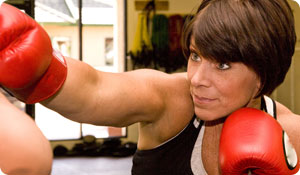
Ever since the 1970s when everybody was Kung Fu Fighting, martial arts-based exercise has been a solid fitness favorite. For the last decade, kickboxing, and its "cousin," cardio-boxing have become popular variations on these challenging workouts, through Tae-Bo, Powerstrike and classes all over the world. Kickboxing is a total-body, booty-kicking workout that's fun, makes you fast on your feet, and kicks you into the best shape of your life.
Think about the moves boxers do when they're not actually punching their opponent. They're shadowboxing, lunging, kicking, swinging, blocking, jabbing, extending their arms, dancing around and constantly moving. They may use props, like speed bags, body bags or padded gloves or they may use just their own body strength.
Both kickboxing and cardio-boxing are taught in one-hour (or ninety minute), nonstop, classes that take you through choreographed drills and martial arts-based combinations of jabs, crosses, hooks, uppercuts, punches, and kicks—all set to heart pumping music.
Regina Brooks, certified fitness instructor at Lloyd Athletic Club in Portland, OR says, "The terms 'kickboxing' and 'cardio-boxing' are often used interchangeably but they're a little different and each provides its own fitness benefits. Kickboxing uses props and there's usually contact made between two participants or 'opponents.' Cardio-boxing doesn't usually include props or contact so it requires different techniques and affects different muscle groups. For example, when you extend your hand and arm to punch a bag (kickboxing), you engage different muscles than when stop yourself just before contact (cardio-boxing). The precision and restraint you use to avoid contact engages your core muscles differently than if you actually hit your target."
What does the American Council on Exercise say about kickboxing? They conducted a study and measured heart rate, caloric consumption, oxygen consumption, and ratings of perceived exertion for each of four kickboxing concentrations: upper-body predominant (e.g., upper cuts, jabs); lower-body predominant (e.g., roundhouse kicks, front and back kicks); combination of upper and lower body; and conditioning (e.g., jumping jacks, simulated rope jumping). They concluded that participants burn about 350-450 calories in an hour-long cardio kickboxing session (about the same as an hour of brisk walking or light jobbing), but cardio kickboxing, also provided increased strength and flexibility, improved coordination and sharper reflexes. Participants maintained a heart rate of 75-85 percent of maximum, well within the recommended 65-85 percent range for aerobic exercise.
Brooks says, "Cardio and kickboxing classes are appropriate for every fitness level. Good teachers know how to guide beginners through safe techniques so they avoid injury. You'll get into great shape, but don't kid yourself; these are not self-defense classes." Look for kickboxing and cardio-boxing classes at your fitness center, community college or on DVD.
Sources:
American Council on Exercise
ACE Research Team Counts Calories, Confirms Benefits of Cardio Kick boxing
http://www.acefitness.org/pressroom/235/ace-research-team-counts-calories-confirms/
Powerstrike
www.powerstrike.com
Billy Blanks Tae-Bo
http://www.billyblanks.com/





